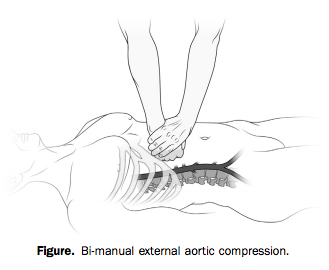Now that our review for Academic Emergency Medicine has been published, I wanted to devote a few words to a discussion that didn’t make it into the article.
We spent a lot of time trying to collate what’s known about one specific phenomenon: the blunt trauma patient with an “unstable” acute injury to his spine who suffers sudden neurological deterioration as a result of ordinary physiological movement. The reason we were interested in this event is because, whether or not we admit it, it’s the basis for our current model of prophylactic spinal immobilization. In other words, the reason we place collars, boards, and other devices on patients until they can be “cleared” is because we want to prevent this phenomenon from occurring.
Anybody who reads our review will probably deduce that we’re a little skeptical about this story. The available data is consistent with a clinical entity that is very rare, and when it does occur may be part of the inevitable natural progression of the disease rather than being a movement-provoked (and hence preventable) event.
This fits well with a rational understanding of the pathophysiology. The only mental model that explains the phenomenon of “sudden collapse” would be something like this: the spinal cord is intact, but is surrounded by a vertebral fracture which is both wholly unstable and contains some kind of knife-like bony structure which is poised to transect the cord given the wrong movement. Or perhaps: the bony integrity of the spine is totally lost at some level, and the cord is holding on purely by a few strands of nerve which (like guitar strings breaking) might pop loose with any movement.
These models might make sense to the naive layperson, but any medical professional who understands bones and nerves will have to admit that they’re a little silly. (A more realistic story of unstable spinal injuries, of course, is that disconnected structures compress the spine, causing real but much less dramatic sequela.) Do they never occur? Well, we can’t say that. They are not physical impossibilities, in the sense that they violate a law of thermodynamics or mathematics or grammar. But they are inconsistent with physiology — and in the absence of outcome data, physiological rationale is the only clay we’re working with.
How much room remains on the table for the sudden, irreversible event described in legend? At this point, it’s fair to say there is very little room. We cannot say there is none. There isn’t enough evidence for that. The knee-jerk EBM reaction is to suggest further study, but as Hauswald pointed out in his commentary, that may not be realistic. To make the distinction between “a very rare thing” and “nothing” would require a study of tremendous size, and even then a critic could still ask for more; proving non-existence is a philosophical impossibility.
But as pragmatists, we can say that “very very very rare” and “nonexistent” are clinically indistinguishable. It’s not impossible that beta blockers can cause anaphylactic reactions, that someone being operated upon could slip off the table, or that the hospital could lose power during a course of mechanical ventilation — yet we don’t feel obliged to inform patients about these risks. At some point, scenarios leave the realm of plausible and foreseeable sequelae and enter the territory of “anything’s possible.”
That being established, the question becomes this: if we banish the specter of the boogeyman, what are we left with? Does the entire concept of spinal immobilization become void? Am I an enemy of the board & collar?
No. Here are some alternate models.
The orthopedic model
This places spinal injury on the same level as other orthopedic diseases.
A patient arrives at the ED with a distal radius fracture. What do we do? We examine it clinically, we manage their pain, we obtain appropriate imaging to help guide our care, and — oh yes — we make some effort to immobilize the injury.
Why? Not because we’re afraid of any boogeyman. We aren’t terrified that if the patient lifts his arm and there is some miniscule movement, a hidden razorblade of bone will cut off his arm and render him immobile. Everyone would look at you like you were wearing a silly hat if you suggested that, because it’s a silly thing to say.
Nevertheless, it is probably wise to to make a good-faith effort at limiting movement around the site of injury. Unnecessary manipulation may promote further trauma to muscles, nerves, and vessels, which could induce unnecessary long-term morbidity, prolong recovery, or at least complicate management and increase acute pain.
And maybe that’s how we should view early spinal care. Nothing dramatic. No boogeymen. Just the same logical, unexciting approach that informs our approach to splints, slings, and casts.
You’ll notice that if we fail to apply those devices for five seconds, nobody freaks out, because it’s not that kind of intervention. You’ll also notice we can study their value in controlled studies without anybody gearing up for a lawsuit.
The “correlation is not causation” models
In our paper’s discussion, we briefly mentioned two possibilities that warrant further attention.
We are all supposedly clever people who understand how easily causation can be assigned to unrelated events, yet when a patient moves their neck or back, and shortly afterwards suffers neurological deterioration, we automatically assume that one caused the other. This is called “temporal association,” and while we can’t help but make the connection, it’s wrong as often as it’s right. (See the unfortunate coincidence of “vaccines caused my child’s autism.”)
Other than the cynical explanations of “this association never occurs” (probably wrong) or “it’s purely coincidence” (possible) there are two more sophisticated models worth considering:
- The Unmasked Inevitability: An injury exists that would eventually have progressed to a worse neurological status (hours, days, or weeks later). However, the trauma of a movement event induces that deficit to present earlier. The long-term outcome is the same, but the deterioration is now temporally linked with the movement.
- The Hidden Aftereffect: Early, unstabilized movement has no immediate effect, but the added insult to the cord promotes edema and other sequelae in the hours/days/weeks that follow. The end result is a poorer long-term outcome that could have been improved by limiting early spinal movement, yet with no obvious association between the two.
Both of these are extremely plausible pathways that we’ve proven to exist in many other diseases. Neither requires the presence of any boogeyman. And since both are completely unrelated to any naive temporal association, either one could only be detected using controlled, outcome-based studies, not this sort of childish anecdote-mongering.
The “forget it, I’m so done” model
Long spine boards may already be on their way out.
EMS services and hospitals around the country are beginning to get aboard the bandwagon of “ditch the backboard in most cases (but keep the collar).” This is very nice. But it’s interesting to examine why it’s happening.
There is no evidence for the benefit of either collars or boards. Any physiological rationale applies equally to both. (Yes, unstable C-spine injuries are somewhat more common than injuries at lower levels, but not so much as to make a difference here.) So why get rid of one but not the other?
It’s because the harms of boards are considered to be greater. There is more evidence that boards cause pain, stasis ulcers, respiratory compromise, and other negatives. However, none of these are major harms, nor are they terribly well demonstrated (most being shown only in small, unreplicated studies where a handful of volunteers were strapped to boards for a few hours). In other words, not exactly a knock-down argument.
If you believe that either device prevents serious morbidity, then these minor risks would not bother you. The only way that the side effects of backboards can be the deciding factor is this: you don’t really think there’s any benefit at all. Some harm + no benefit = out they go.
But remember that on any analysis, the benefits of boards vs. collars are equal zeroes. So once again… why keep one and ditch the other?
The true explanation of the backboard exodus seems to be that everybody finally threw up their hands and said collectively, “I’ve had it with these stupid things.” There was no landmark study or historical turning point. We just saw the writing on the wall.
Since they’re of a kind, the same thing might eventually happen to collars.
Do I think this would be a great idea? No. Because as we’ve discussed in this post, even if we exorcise the boogeyman from our thinking, that doesn’t mean there can’t be any benefit from these devices. It just means the possible benefit becomes more boring and less dramatic, and can now be studied, quantified, and weighed against other factors, rather than being an unassailable matter of dogma. And rather than burning our boards and collars, it means we’re free to recruit them in flexible and useful ways (such as using boards to move patients when it’s the most convenient method, or using collars to stabilize the necks of intubated patients when it’s helpful), rather than invoking them ritualistically.
So what now?
I hope these remarks shine a little light on some possible ways forward. I think many people feel that, if we drop the current model of early spinal care, we’re left with emptiness and nihilism. But really, the current model is based upon a fairytale: if we use our [talisman], we’ll keep away the [boogeyman]. Fairytale-based thinking prevents better understanding, because you can’t study a fairytale. Once we banish that, the entire disease opens up to the kind of rational approach that can stand alongside the rest of our armamentarium, and becomes amenable to the sort of boring explication offered by clinical research.
This is good. Do not fear it.



Recent Comments